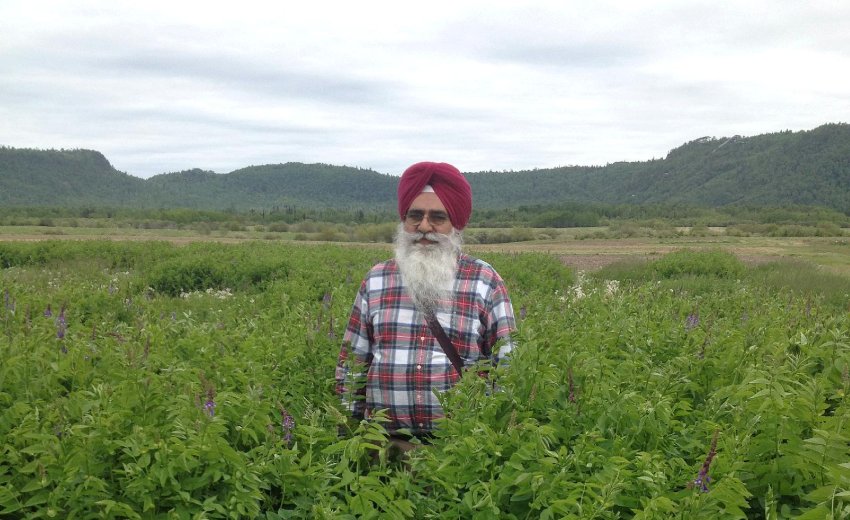
Dr. Tarlock Singh Sahota, right, director of research at the Thunder Bay Agricultural Research Station, talks to local farmer Allan Mol during the yearly tour of the station.
A field of brilliant yellow canola that rolled towards the distant NorWester mountains was a fitting backdrop on Wednesday as a group of people involved in local farming learned about some of the latest agricultural research for Northwestern Ontario.
Taking part in the annual tour of the Thunder Bay Agricultural Research Station, the group walked the land and listened as Dr. Tarlok Singh Sahota, director of research, talked about the close to 40 crops growing in the test fields, including nine new ones such as yellow mustard, quinoa, and perennial wheatgrass.
The yearly tour is an opportunity for local farmers — and those working in the agricultural industry — to see what sorts of things are being done at the research station.
“We show the work we do that impacts farms and helps farmers diversify cropping systems, improve yield and profitability,” said Sahota.
One of the newer crops that Sahota is excited to discuss and one that may be seen popping up in more fields locally over the next few years is galega.
The perennial legume that comes from Scandinavia could be a rival to the commonly grown alfalfa, explained Sahota.
With its high yield and high protein content, galega can be grown as forage for cattle.
Local dairy farmer, Bernie Kamphof said he just started growing the crop this year and since it takes a year to establish he won’t be harvesting until next season.
“(One) potential benefit, it should grow in cooler weather than alfalfa does,” said Kamphof, who has between 20 and 25 acres of it growing on his farm.
Kamphof, who is a member of the board of the research station, said he did some research about the crop on his own before planting, but it was hard to find anything about growing it in North America.
“This is the only place that has any information on it,” said Kamphof. “To the best of my knowledge we’re the first ones in North America really trying it on a commercial scale.”

Farmer Peter Aaalbers' field. He was the first to follow Dr. Tarlock Singh's recommendation and become the first Galega grower in Ontario/and Canada.
Trials of growing galega began at the research station in Thunder Bay and at the one in New Liskeard in 2009, explained Sahota. That first year, the yields were only 90 per cent of yields of alfalfa, not an encouraging statistic for farmers.
“Any other person in my place would have given up, it’s not better than alfalfa,” said Sahota.
But Sahota’s passion for research and agriculture pushed him to look at the problem differently. When he tried planting the seeds deeper in the soil, the crop improved to give it a higher yield than alfalfa.
“Research needs a lot of persistence,” said Sahota. “If you fail at one step it doesn’t mean that’s the end. Try to see what will make it a success, what is lacking. We do that type of analysis and that’s why galega is a success now.”
In 2015 a local farmer planted 40 acres of galega, said Sahota, and when he harvested last year he found it produced higher yields than alfalfa, so this year he put in another 60 acres of galega.
“It’s a success story,” said Sahota, which led Thunder Bay Feeds to import 4,000 metric tons of seed that went to approximately 20 farmers across Ontario.
While there is still a lot to learn about growing this new crop as every farm field is different, Kamphof said, “It would be unlikely that I would have tried something like that without the work that’s been happening at the research station here.”
Besides introducing new crops to the region, the research station also does a lot of work with fertilizers and how to make farms more efficient, said Kamphof.
Allan Mol, a local dairy farmer, said the value of having the research station here is it’s close to home.
“That’s the biggest thing, and grown in a northern climate,” said Mol. “They work with typical constraints we work with to see if it’s economically feasible too. Having the station here is mainly to show it can be done.”
